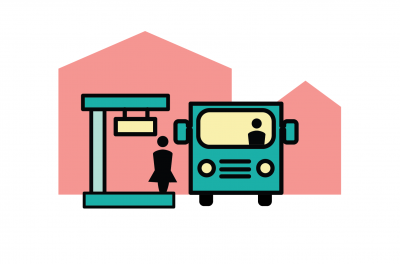 Travel Behavior
Travel Behavior
Travel patterns vary between demographic and socioeconomic factors shaping how people get around
Travel behavior represents the spaces and ways that people get around: how far they travel, where they go, by which modes, at which times, which whom, for what purposes. Socioeconomic factors — race, income, and gender — shape travel patterns and travel needs. Access to adequate transportation continues to be a struggle for low-income households despite advances in transportation infrastructure and policy. Automobile ownership in the United States has increased, and yet access to automobiles is limited for low-income households. Difficulty in automobile access alters the nature of trips and access to work for many low-income families. With increasing suburbanization, especially among poor people, low-income families in the suburbs face challenges to meet their travel needs given their decreased ownership rates and the auto-orientation of the suburbs.
Other individual factors shape travel — namely, race, gender and ability. Gender shapes travel patterns in two main ways. Safety and security concerns influence women’s travel patterns and their mode choice. Sexual harassment concerns limit the times of day women feel comfortable using transit, leading to restricted mobility for those without other options. Safety concerns lead to a variety of other strategies for avoidance including dressing certain ways or only taking transit from certain stops or locations. In addition to safety, women have traditionally made shorter trips, used transit more than men, and are responsible for more of the household-serving errands and caregiving responsibilities. While women may use transit more than men in some cases, it’s also true that women’s complex travel needs are sometimes more suited for travel by car. This is due, in part, to the fact that trip-chaining, where multiple stops are made on the way to somewhere, is a common component of women’s travel patterns. Although some convergence between women’s and men’s travel patterns has occurred, especially due to women’s increased workforce participation, the gender gap in travel behavior still exists: Women have greater safety and security concerns and they trip-chain more than men.
Age further determines travel behavior, most specifically for youth and older adults who travel differently than the rest of the population, due mostly to the decreased reliance on driving one’s self. Travel patterns based on age also intersect and vary based on immigration status, racial and ethnic identity, and where people live. As the ability to drive withers, older adults become more reliant on transit or on receiving rides from other people. There are older adults who because of economic disadvantage, immigration status, or gender, never owned a car or learned to drive historically so do not rely on automobiles. Young people also have distinct travel patterns, similarly but not exclusively related to the lack of a driver’s license. Economic factors, including the economic recession in 2007, have contributed to a decline in youth’s reliance on automobiles.
In addition to these other identities, travel patterns vary by immigration status. For example, carpooling is more prominent among immigrant communities than others. In Southern California, carpooling rates are much higher in areas with a high percentage of foreign-born individuals. Varied travel needs of immigrants also affect transportation infrastructures, particularly in regions with a large population of immigrants. Such findings further suggest the benefits of future transportation policies that cater to the specific needs of residents.
Examining how people travel relies heavily on understanding the fact that more than one identity influences how people travel and what their related level of transportation access is. Race, income, gender, immigration status, and age are interconnected, which is why transportation research requires a broader understanding of travel behavior, the constraints people face, and the opportunities to enhance the quality of the transportation experience.
Further Reading from UCLA Scholars
Agrawal, A. W., Blumenberg, E., Abel, S., Pierce, G., & Dannah, C. (2011). Getting around when you’re just getting by: The travel behavior and transportation expenditures of low-income adults (No. 10–02). Mineta Transportation Institute. https://rosap.ntl.bts.gov/view/dot/18612
Blumenberg, E. A, & Ong, P. M. (2002). Cars, buses, and jobs: Welfare Participants and Employment Access in Los Angeles. UC Berkeley: University of California Transportation Center. Retrieved from https://escholarship.org/uc/item/8n55f7bd
Blumenberg, E. A. (2003). En-gendering Effective Planning: Spatial Mismatch, Low-Income Women, and Transportation Policy. UC Berkeley: University of California Transportation Center. Retrieved from https://escholarship.org/uc/item/7kc7v38f
Brown, Anne E., et al. 2016. A Taste for Transit? Analyzing Public Transit Use Trends among Youth. Journal of Public Transportation, 19 (1): 49-67. DOI: http://doi.org/10.5038/2375-0901.19.1.4 Available at: https://scholarcommons.usf.edu/jpt/vol19/iss1/4
Loukaitou-Sideris, A., Brozen, M., & Levy-Storms, L. (2018). Bolstering Mobility and Enhancing Transportation Options for Low-Income Older Adults. UCLA: The Ralph and Goldy Lewis Center for Regional Policy Studies. Retrieved from https://escholarship.org/uc/item/5bt0m87c
LA Metro (2019) Understanding how women travel, Appendix A: Literature Review Los Angeles County Metropolitan Transportation Authority http://libraryarchives.metro.net/DB_Attachments/2019-0294/HWT_AppendixA_FINAL.pdf
